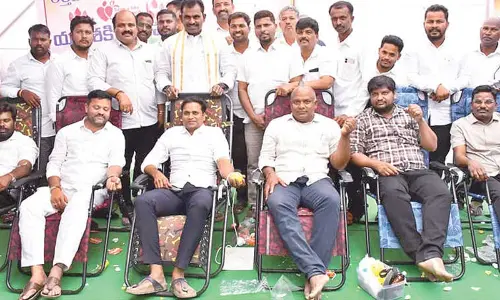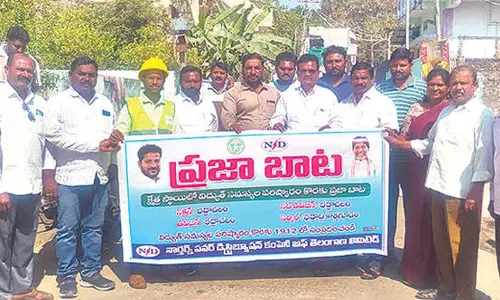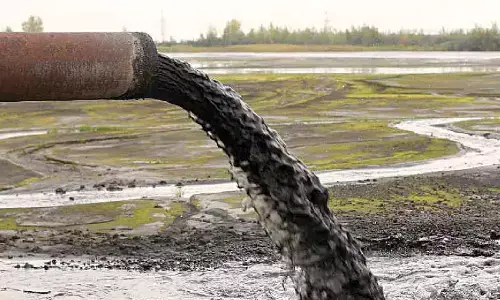Water warriors of conservation kind Have their eyes heritage lakes

Uniting against the dwindling water resources in their town, the people of Moodbidri, nestled amidst the verdant foothills of the Western Ghats and the majestic Arabian Sea
Moodbidri: Uniting against the dwindling water resources in their town, the people of Moodbidri, nestled amidst the verdant foothills of the Western Ghats and the majestic Arabian Sea, have earned the moniker 'Jain Kashi' for their cherished Jain heritage structures, Basadis, and religious tourism. Taking matters into their own hands, they have initiated a remarkable endeavor to revive the town's 18 water bodies without relying on government assistance. Driven by social service clubs and enthusiastic youths from colleges and schools, this grassroots movement has sparked a ray of hope for their community.
Driven by three key activists- P Kurien Thomas, Maqbool Hussain and Dr. Muralikrishna had done superhuman efforts to move the social service clubs, the local water warriors, legislators and common people to take up rejuvenation of 18 lakes, tanks and bogs to their pristine beauty and utility. “These are ancient tanks and belongs to the antiquity of Moodbidri and must be preserved in their pristine conditions with some modern techniques of water conservation and embankment development. Out of the 18 we have rejuvenated Kadalakere which has 40 acres and biggest among the water bodies. This was taken under the guidance of late Dr. L C Soans and today it is turning into a bird sanctuary and tourist place.Similarly the Mohalla Kere which was once a dumping site for municipal waste is now brimming with clean potable water and adds to the beauty of the locality. The biggest success was Kemplaje Kere which is an ancient agriculture water body which had been in the state of disuse for many decades if not a century, but thanks to the help of the people of Moodbidri and the Rotary club the waterbody is totally rejuvenated and returned to its fullest capacity” said P K Thomas.
Recognizing the alarming decline in water levels across the town's water bodies due to urbanization, the residents have realized the imminent water shortage threat. In 2016, the once perennial lakes, ponds, bogs, and tanks had dried up, prompting the realization that their reliance on the Puchchemogaru dam's water from the Phalguni river was not a sustainable long-term solution. To tackle this challenge, they formed a proactive citizens' group, aided by various social service clubs, to identify the potential of the existing 18 water bodies in harnessing rainwater and replenishing their reserves.
“Another big water body is that of Basavanakaje at a place called Alangaru village which is over 10 acres. The CDD India which is a non profit organisation working in water and nature conservation and solutions, has taken interest in taking up the total conservation of the Basavanakaje lake in Alangar village. This site is now filled with silt and may need embankment, desilting and area fortification” said Dr Amrit Malla a senior conservation activist.
Their mission was straightforward yet paramount: desilt the tanks, restore their functionality, and ensure rainwater retention. Notably, their efforts bore fruit with the successful rejuvenation of the Mohalla Kere in early 2017. Spread across 1.7 acres, this once lifeless water body now brims with clean, potable water. The ripple effect of this achievement led to over 100 dug wells experiencing a rejuvenation, benefiting not only 100 households but also catering to an additional 200 families' water needs, marking a significant self-sufficiency milestone.
Buoyed by this triumph, the working group, spearheaded by Dr. Muralikrishna, tackled the Uliya Kere renovation in December 2017. Emphasizing the importance of public participation and collaboration with organizations like Rotary and Dharmasthala temples, the project revitalized the multi-level water body, ensuring that not one but three tanks are now brimming with fresh water.
Looking ahead, the dedicated team has identified Subhashnagar Kere as their next summer revival project, with the Dharmasthala temple trust already pledging support. Despite challenges, such as disappearing tanks like Ankasalay, they persevere in re-surveying and removing silt, winning the hearts of the people living around all 18 water bodies.
Enthusiastic about their progress, Prof. Pundikai Ganapayya Bhat, who guided the group, highlighted the invaluable experience gained from Mohalla Kere's revival, paving the way for other water bodies' restoration. The collaborative effort between the Rotary Club of Moodbidri and the community indicates a promising future for this initiative.
Presently, Moodbidri draws 4 million liters of water from the slimming Phalguni river through the Puchchemogaru dam. However, during summers and tourist seasons, water consumption surges by 30%. To address this, significant water bodies, such as Ankasaley, Gowri Kere, Subhashnagar, Kadedabettu, Kalyani Kere, Basavana Kaje, Uliya Kere, and Aramane Bagilu Kere, have captured the attention of the citizens, offering hope for a sustainable future.
Among these, Gowri Kere, situated on the town's higher level, holds water until the end of March, and its revival can prolong its water retention capabilities. Says Maqbool Hussain. eagerly nominates Gowri Kere as the next priority for rejuvenation.
The spirited community of Moodbidri stands united, unwavering in their mission to restore their precious water bodies, paving the way for a brighter and more water-secure future for all.
















